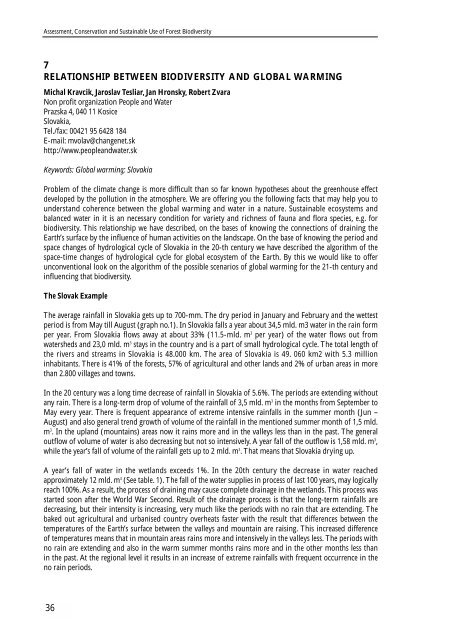Assessment, Conservation and Sustainable Use of Forest Biodiversity
Assessment, Conservation and Sustainable Use of Forest Biodiversity
Assessment, Conservation and Sustainable Use of Forest Biodiversity
Create successful ePaper yourself
Turn your PDF publications into a flip-book with our unique Google optimized e-Paper software.
<strong>Assessment</strong>, <strong>Conservation</strong> <strong>and</strong> <strong>Sustainable</strong> <strong>Use</strong> <strong>of</strong> <strong>Forest</strong> <strong>Biodiversity</strong><br />
7<br />
RELATIONSHIP BETWEEN BIODIVERSITY AND GLOBAL WARMING<br />
Michal Kravcik, Jaroslav Tesliar, Jan Hronsky, Robert Zvara<br />
Non pr<strong>of</strong>it organization People <strong>and</strong> Water<br />
Prazska 4, 040 11 Kosice<br />
Slovakia,<br />
Tel./fax: 00421 95 6428 184<br />
E-mail: mvolav@changenet.sk<br />
http://www.people<strong>and</strong>water.sk<br />
Keywords: Global warming; Slovakia<br />
Problem <strong>of</strong> the climate change is more difficult than so far known hypotheses about the greenhouse effect<br />
developed by the pollution in the atmosphere. We are <strong>of</strong>fering you the following facts that may help you to<br />
underst<strong>and</strong> coherence between the global warming <strong>and</strong> water in a nature. <strong>Sustainable</strong> ecosystems <strong>and</strong><br />
balanced water in it is an necessary condition for variety <strong>and</strong> richness <strong>of</strong> fauna <strong>and</strong> flora species, e.g. for<br />
biodiversity. This relationship we have described, on the bases <strong>of</strong> knowing the connections <strong>of</strong> draining the<br />
Earth’s surface by the influence <strong>of</strong> human activities on the l<strong>and</strong>scape. On the base <strong>of</strong> knowing the period <strong>and</strong><br />
space changes <strong>of</strong> hydrological cycle <strong>of</strong> Slovakia in the 20-th century we have described the algorithm <strong>of</strong> the<br />
space-time changes <strong>of</strong> hydrological cycle for global ecosystem <strong>of</strong> the Earth. By this we would like to <strong>of</strong>fer<br />
unconventional look on the algorithm <strong>of</strong> the possible scenarios <strong>of</strong> global warming for the 21-th century <strong>and</strong><br />
influencing that biodiversity.<br />
The Slovak Example<br />
The average rainfall in Slovakia gets up to 700-mm. The dry period in January <strong>and</strong> February <strong>and</strong> the wettest<br />
period is from May till August (graph no.1). In Slovakia falls a year about 34,5 mld. m3 water in the rain form<br />
per year. From Slovakia flows away at about 33% (11.5-mld. m 3 per year) <strong>of</strong> the water flows out from<br />
watersheds <strong>and</strong> 23,0 mld. m 3 stays in the country <strong>and</strong> is a part <strong>of</strong> small hydrological cycle. The total length <strong>of</strong><br />
the rivers <strong>and</strong> streams in Slovakia is 48.000 km. The area <strong>of</strong> Slovakia is 49. 060 km2 with 5.3 million<br />
inhabitants. There is 41% <strong>of</strong> the forests, 57% <strong>of</strong> agricultural <strong>and</strong> other l<strong>and</strong>s <strong>and</strong> 2% <strong>of</strong> urban areas in more<br />
than 2.800 villages <strong>and</strong> towns.<br />
In the 20 century was a long time decrease <strong>of</strong> rainfall in Slovakia <strong>of</strong> 5.6%. The periods are extending without<br />
any rain. There is a long-term drop <strong>of</strong> volume <strong>of</strong> the rainfall <strong>of</strong> 3,5 mld. m 3 in the months from September to<br />
May every year. There is frequent appearance <strong>of</strong> extreme intensive rainfalls in the summer month (Jun –<br />
August) <strong>and</strong> also general trend growth <strong>of</strong> volume <strong>of</strong> the rainfall in the mentioned summer month <strong>of</strong> 1,5 mld.<br />
m 3 . In the upl<strong>and</strong> (mountains) areas now it rains more <strong>and</strong> in the valleys less than in the past. The general<br />
outflow <strong>of</strong> volume <strong>of</strong> water is also decreasing but not so intensively. A year fall <strong>of</strong> the outflow is 1,58 mld. m 3 ,<br />
while the year’s fall <strong>of</strong> volume <strong>of</strong> the rainfall gets up to 2 mld. m 3 . That means that Slovakia drying up.<br />
A year’s fall <strong>of</strong> water in the wetl<strong>and</strong>s exceeds 1%. In the 20th century the decrease in water reached<br />
approximately 12 mld. m 3 (See table. 1). The fall <strong>of</strong> the water supplies in process <strong>of</strong> last 100 years, may logically<br />
reach 100%. As a result, the process <strong>of</strong> draining may cause complete drainage in the wetl<strong>and</strong>s. This process was<br />
started soon after the World War Second. Result <strong>of</strong> the drainage process is that the long-term rainfalls are<br />
decreasing, but their intensity is increasing, very much like the periods with no rain that are extending. The<br />
baked out agricultural <strong>and</strong> urbanised country overheats faster with the result that differences between the<br />
temperatures <strong>of</strong> the Earth’s surface between the valleys <strong>and</strong> mountain are raising. This increased difference<br />
<strong>of</strong> temperatures means that in mountain areas rains more <strong>and</strong> intensively in the valleys less. The periods with<br />
no rain are extending <strong>and</strong> also in the warm summer months rains more <strong>and</strong> in the other months less than<br />
in the past. At the regional level it results in an increase <strong>of</strong> extreme rainfalls with frequent occurrence in the<br />
no rain periods.<br />
36

















